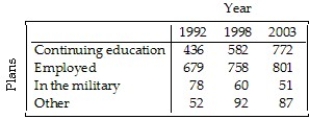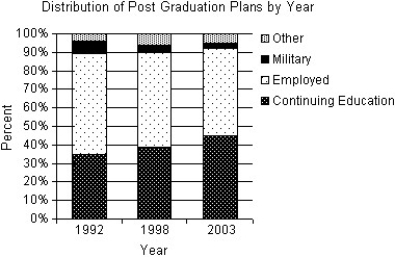The table below compares what students at a small Canadian college did after graduating with a bachelor's degree in 1992,1998,and 2003.A graphical display of the conditional distributions of what students did after graduation by year is given. 

Does this study present any evidence that postgraduation plans have changed over this 11-year period? Explain.
A) Yes.There is evidence that the percentage of graduates entering the work force after graduation has increased from 1992 to 2003.Likewise,the percentage of graduates continuing their education appears to have decreased from 1992 to 2003.
B) Yes.There is evidence that the percentage of graduates continuing their education has increased from 1992 to 2003.Likewise,the percentage of graduates entering the work force after graduation appears to have decreased from 1992 to 2003.
C) No.The percentage of graduates continuing their education has increased from 1992 to 2003.Likewise,the percentage of graduates entering the work force after graduation appears to have decreased from 1992 to 2003.However,this is not sufficient evidence to show any change due to the fact that those entering the military or seeking other options remained relatively constant.
D) No.The percentage of graduates continuing their education has increased from 1992 to 2003.Likewise,the percentage of graduates entering the work force after graduation appears to have decreased from 1992 to 2003.However,this is not sufficient evidence to show any change due to the fact that the number of students graduating has increased over this same time period.
E) Yes.There is evidence that the percentage of graduates continuing their education and entering the work force after graduation has increased from 1992 to 2003.
Correct Answer:
Verified
Q51: A prediction of the number of medals
Q52: The City of Windsor Department of Parks
Q53: Students in a Political Science course were
Q54: Statistics Canada gives the following mortality data
Q55: Most women who have had a mastectomy
Q57: The focus of a recent survey was
Q58: A company held a cholesterol screening clinic
Q59: A company must decide which of two
Q60: Students in a political science course were
Q61: A survey of automobiles parked in student
Unlock this Answer For Free Now!
View this answer and more for free by performing one of the following actions

Scan the QR code to install the App and get 2 free unlocks

Unlock quizzes for free by uploading documents